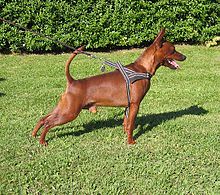Miniature Pinscher
| Miniature Pinscher | ||
|---|---|---|
|
|
||
| FCI Standard No. 185 | ||
|
||
| Origin : | ||
| Alternative names: |
Rehpinscher, Miniature Pinscher, Minpin, Minidoberman; in Austria also deer rattler known |
|
| Withers height: |
25-30 cm |
|
| Weight: |
4-6 kg |
|
| Varieties : |
|
|
| List of domestic dogs | ||


The Miniature Pinscher , also called Rehpinscher , is a German dog breed recognized by the FCI ( FCI Group 2, Section 1.1, Standard No. 185 ).
Origin and history
In 1895 Josef Berta called for the founding of a pinscher club. At the time there were two clubs in Germany that then merged. Until the early years of the 20th century, both rough-haired and smooth-haired pups fell together in the litters. Josef Berta started pure breeding. Only then did the distinction between pinschers and schnauzers emerge .
In Germany, the Pinscher-Schnauzer-Klub 1895 is the only breed breeding association recognized by the Association for the German Dog Industry (VDH) and is therefore responsible for the standard of the breed .
description
"The Miniature Pinscher is the scaled-down image of the German Pinscher , without the defects of dwarfish appearances." The coat is smooth, very short and without undercoat . It is sleek and the entire body should be harmonious, with well-distributed muscles and a square body with a size of 25–30 cm and a weight of 4–6 kg. The head is strong, elongated, without a strongly protruding occiput. The bridge of the nose is straight and runs parallel to the extension of the wrinkle-free, flat forehead with the slight but clear stop (forehead heel). The strong muzzle ends in a blunt wedge. The tip of the nose is full and black; the lips lie well and are dark in color. The ears are set high, carried evenly upright in a V-shape with folding crease or erect ears.
Essence
The Miniature Pinscher is a very affectionate dog and has a tendency to associate closely with a single person. He is very curious and has a strong urge to move. Underemployed, this breed tends to be nervous. Therefore they have to be challenged both mentally and physically. This can be achieved with hikes, longer excursions, but also dog sports such as agility or dog dancing . The Miniature Pinscher is very attentive in character and has a low stimulus threshold.
Diseases typical of the breed
The acral Mutilationssyndrom is a very rare congenital nerve disease with self-mutilation of the paws, for which a case has been described in a Miniature Pinscher. In addition, there is a breed disposition for mucopolysaccharidosis type VI .
Literature and film
Theodor Fontane mentions the pinscher in the novel Der Stechlin as an avid rat and mouse catcher. In the film adaptation of the novel The Third Man , Baron Kurtz holds a miniature pinscher in his arms, who later went to Dr. Winkel appears, subtly suggesting complicity in its unexpected presence.
Individual evidence
- ↑ Breed standard No. 185 of the FCI: Miniature Pinscher (PDF)
- ↑ M. Bardagí, P. Montoliu, L. Ferrer, D. Fondevila, M. Pumarola: Acral mutilation syndrome in a miniature pinscher. In: Journal of comparative pathology. Volume 144, Number 2-3, 2011 Feb-Apr, pp. 235-238, doi : 10.1016 / j.jcpa.2010.08.014 , PMID 20961556 .
- ^ Margret L. Casal: Hereditary diseases. In: Peter S. Suter, Barbara Kohn: Internship at the dog clinic. 10th edition, Paul Parey, Stuttgart 2006, ISBN 978-3-8304-4141-0 , p. 194.
